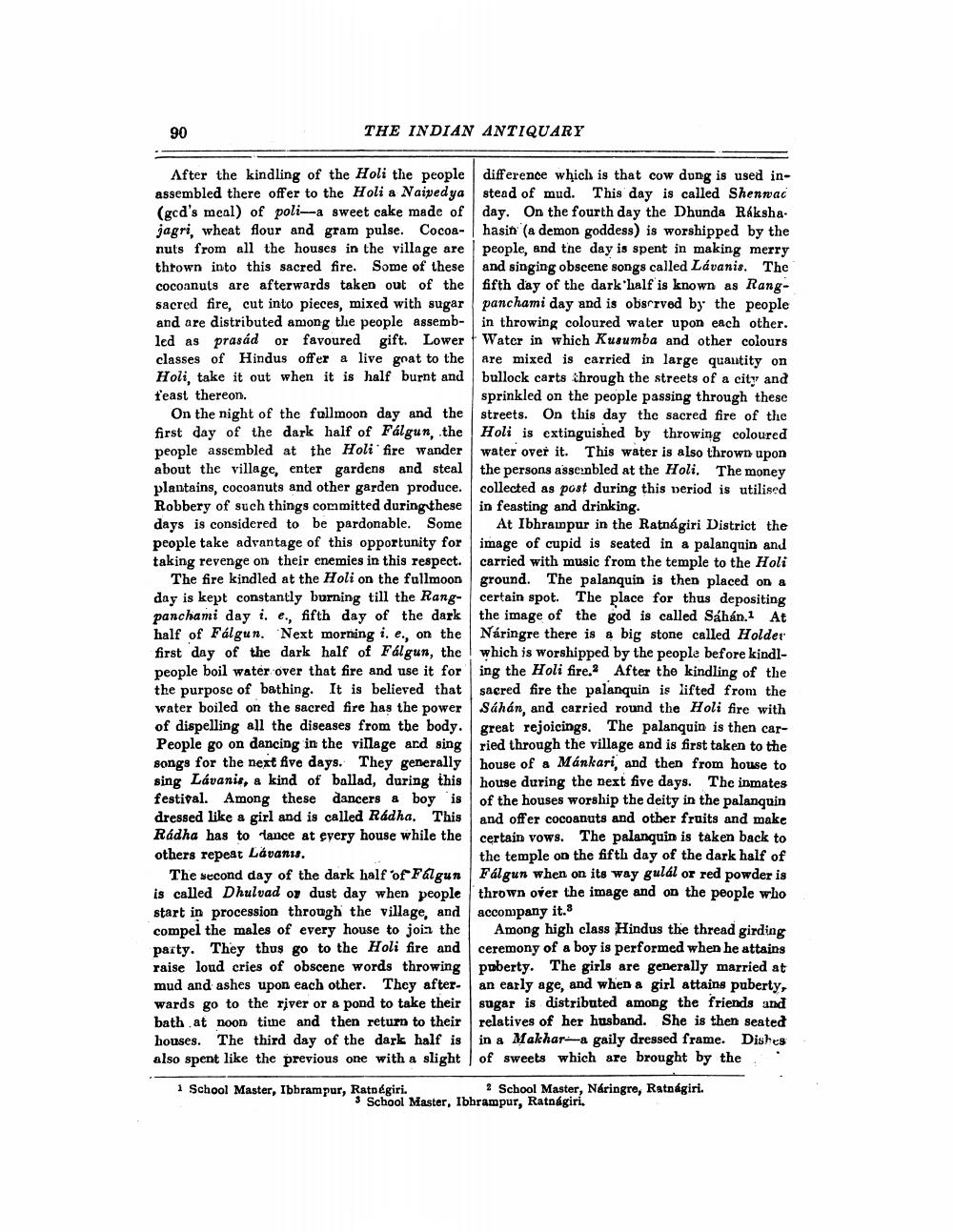________________
90
THE INDIAN ANTIQUARY
After the kindling of the Holi the people assembled there offer to the Holi a Naivedya (gcd's meal) of poli-a sweet cake made of jagri, wheat flour and gram pulse. Cocoanuts from all the houses in the village are thrown into this sacred fire. Some of these cocoanuts are afterwards taken out of the sacred fire, cut into pieces, mixed with sugar and are distributed among the people assembled as prasád or favoured gift. Lower classes of Hindus offer a live goat to the Holi, take it out when it is half burnt and feast thereon.
On the night of the fullmoon day and the first day of the dark half of Fálgun, the people assembled at the Holi fire wander about the village, enter gardens and steal plantains, cocoanuts and other garden produce. Robbery of such things committed during these days is considered to be pardonable. Some people take advantage of this opportunity for taking revenge on their enemies in this respect.
The fire kindled at the Holi on the fullmoon day is kept constantly burning till the Rangpanchami day i. e., fifth day of the dark half of Fálgun. Next morning i. e., on the first day of the dark half of Fálgun, the people boil water over that fire and use it for the purpose of bathing. It is believed that water boiled on the sacred fire has the power of dispelling all the diseases from the body. People go on dancing in the village and sing songs for the next five days. They generally sing Lávanis, a kind of ballad, during this festival. Among these dancers a boy is dressed like a girl and is called Rádha. This Rádha has to dance at every house while the others repeat Lávanis.
The second day of the dark half of Falgun is called Dhulvad or dust day when people start in procession through the village, and compel the males of every house to join the party. They thus go to the Holi fire and raise loud cries of obscene words throwing mud and ashes upon each other. They afterwards go to the river or a pond to take their bath at noon time and then return to their houses. The third day of the dark half is also spent like the previous one with a slight
1 School Master, Ibbrampur, Ratnégiri.
difference which is that cow dung is used instead of mud. This day is called Shenwac day. On the fourth day the Dhunda Rakshahasin (a demon goddess) is worshipped by the people, and the day is spent in making merry and singing obscene songs called Lávanis. The fifth day of the dark half is known as Rangpanchami day and is observed by the people in throwing coloured water upon each other. Water in which Kusumba and other colours are mixed is carried in large quantity on bullock carts through the streets of a city and sprinkled on the people passing through these streets. On this day the sacred fire of the Holi is extinguished by throwing coloured water over it. This water is also thrown upon the persons assembled at the Holi. The money collected as post during this period is utilised in feasting and drinking.
At Ibhrampur in the Ratnagiri District the image of cupid is seated in a palanquin and carried with music from the temple to the Holi ground. The palanquin is then placed on a certain spot. The place for thus depositing the image of the god is called Sáhán.1 At Náringre there is a big stone called Holder which is worshipped by the people before kindling the Holi fire. After the kindling of the sacred fire the palanquin is lifted from the Súhán, and carried round the Holi fire with great rejoicings. The palanquin is then carried through the village and is first taken to the house of a Mánkari, and then from house to house during the next five days. The inmates of the houses worship the deity in the palanquin and offer cocoanuts and other fruits and make certain vows. The palanquin is taken back to the temple on the fifth day of the dark half of Fálgun when on its way gulál or red powder is thrown over the image and on the people who accompany it.3
Among high class Hindus the thread girding ceremony of a boy is performed when he attains puberty. The girls are generally married at an early age, and when a girl attains puberty, sugar is distributed among the friends and relatives of her husband. She is then seated in a Makhara gaily dressed frame. Dishes of sweets which are brought by the
2 School Master, Náringre, Ratnagiri.
3 School Master, Ibhrampur, Ratnagiri.




